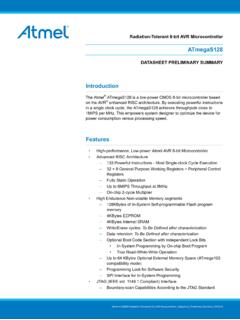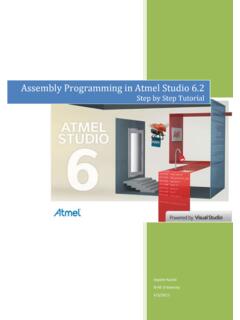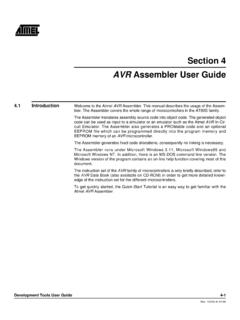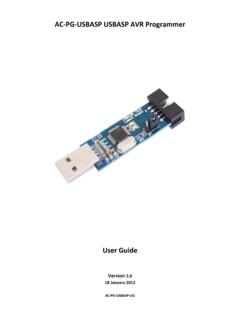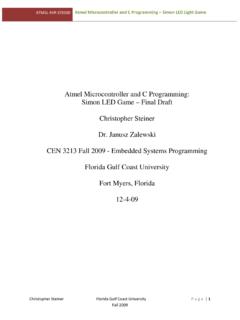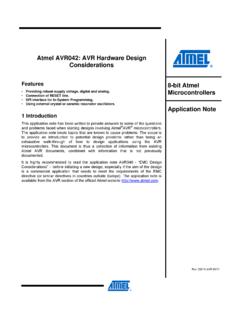Transcription of Introduction Features - aerosupport.atmel.com
1 Radiation-Tolerant 8-bit avr microcontroller ATmegaS128 DATASHEET COMPLETEI ntroductionThe Atmel ATmegaS128 is a low-power CMOS 8-bit microcontroller basedon the AVR enhanced RISC architecture. By executing powerful instructionsin a single clock cycle, the ATmegaS128 achieves throughputs close to1 MIPS per MHz. This empowers system designer to optimize the device forpower consumption versus processing High-performance, Low-power atmel avr 8-bit Microcontroller Advanced RISC Architecture 133 Powerful Instructions - Most Single-clock Cycle Execution 32 8 General Purpose Working Registers + Peripheral ControlRegisters Fully Static Operation Up to 8 MIPS Throughput at 8 MHz On-chip 2-cycle Multiplier High Endurance Non-volatile Memory segments 128 KBytes of In-System Self-programmable Flash programmemory 4 KBytes EEPROM 4 KBytes Internal SRAM Write/Erase cycles: 10k Flash(1) / 20k EEPROM Data retention.
2 10 years @ 125 C Optional Boot Code Section with Independent Lock Bits In-System Programming by On-chip Boot Program True Read-While-Write Operation Up to 64 KBytes Optional External Memory Space Programming Lock for Software Security SPI Interface for In-System ProgrammingNote: 1. In flight flash programming under specific conditions - Seeapplication note 41086 Atmel-41036D-Radiation-Tolerant 8-bit AVR Microcontroller_Datasheet_Complete-02/20 17 JTAG (IEEE std. Compliant) Interface Boundary-scan Capabilities According to the JTAG Standard Extensive On-chip Debug Support Programming of Flash, EEPROM, Fuses and Lock Bits through the JTAG Interface Peripheral Features Two 8-bit Timer/Counters with Separate Prescalers and Compare Modes Two Expanded 16-bit Timer/Counters with Separate Prescaler, Compare Mode and CaptureMode Real Time Counter with Separate Oscillator Two 8-bit PWM Channels 6 PWM Channels with Programmable Resolution from 2 to 16 Bits Output Compare Modulator 8-channel, 10-bit ADC 8 Single-ended Channels 7 Differential Channels 2 Differential Channels with Programmable Gain at 1x, 10x.
3 Or 200x Byte-oriented Two-wire Serial Interface Dual Programmable Serial USARTs Master/Slave SPI Serial Interface Programmable Watchdog Timer with On-chip Oscillator On-chip Analog Comparator Special Microcontroller Features Power-on Reset and Programmable Brown-out Detection Internal Calibrated RC Oscillator External and Internal Interrupt Sources Six Sleep Modes: Idle, ADC Noise Reduction, Power-save, Power-down, Standby, andExtended Standby Software Selectable Clock Frequency ATmega103 Compatibility Mode Selected by a Fuse Global Pull-up Disable I/O and Packages 53 Programmable I/O Lines 64-lead Ceramic Quad Flat Package (CQFP64) 64-lead Thin Profile Plastic Quad Plat Package (TQFP64) Operating range Voltage : 3V to Temperature : -55 C to +125 C Speed Grades 0 - 8 MHz Radiation Tolerance No Single Event Latch-up below a LET threshold of MeV/mg/cm2@125 C Tested up to a Total Ionizing Dose of 30 krads(Si) according to MIL-STD-883 Method 1019 ESD better than : 2000V HBM / 750V CDM Mass : gAtmel ATmegaS128 [DATASHEET]Atmel-41036D-Radiation-Tolera nt 8-bit AVR Microcontroller_Datasheet_Complete-02/20 172 Table of Quality and ATmegaS128 Compatibility Mode (External Data Memory Mode).
4 Code CPU Arithmetic Logic Purpose Register Execution and Interrupt Reprogrammable Flash Program Data Data Memory Clock and Clock Systems and their Clock Crystal RC Internal RC Management and Sleep Noise Reduction Standby Power Control and the Voltage Sequences for Changing the Configuration of the Watchdog Vectors in as General Digital Port , Timer/Counter2, and Timer/Counter1 Clock Clock Timer/Counter (Timer/Counter1 and Timer/Counter3).. 16-bit Clock 136 Atmel ATmegaS128 [DATASHEET]Atmel-41036D-Radiation-Tolera nt 8-bit AVR Microcontroller_Datasheet_Complete-02 Capture Compare Match Output of Timing Timer/Counter0 with PWM and Asynchronous Clock Compare Match Output of Timing Operation of the Timer/Counter2 with Clock Compare Match Output of Timing Compare Modulator (OCM1C2).
5 Serial Peripheral Pin Transmission The USART 246 Atmel ATmegaS128 [DATASHEET]Atmel-41036D-Radiation-Tolera nt 8-bit AVR Microcontroller_Datasheet_Complete-02 Reception The USART Data Communication of Baud Rate - Two-wire Serial Serial Interface Bus Transfer and Frame Bus Systems, Arbitration and the Systems and Comparator Multiplexed - Analog to Digital a and Conversion Channel or Reference Noise Conversion Interface and On-chip Debug Test Access the Boundary-scan the On-chip Debug Debug Specific JTAG the JTAG Programming (JTAG) Specific JTAG Boundary-scan Description Language ATmegaS128 [DATASHEET]Atmel-41036D-Radiation-Tolera nt 8-bit AVR Microcontroller_Datasheet_Complete-02 - Boot Loader Support Read-While-Write and Boot Loader Flash and No Read-While-Write Flash Loader Lock the Boot Loader the Flash During the (1)
6 And Data Memory Lock Programming Parameters, Pin Mapping, and Programming Pin Via the JTAG and Reset Serial Interface Programming Timing Data Memory Supply Supply Supply Supply Supply Thresholds and Analog Comparator Oscillator Consumption of Peripheral Consumption in Reset and Reset Pulse Set 442 Atmel ATmegaS128 [DATASHEET]Atmel-41036D-Radiation-Tolera nt 8-bit AVR Microcontroller_Datasheet_Complete-02 Rev. Revision 41036D - 02 41036C - 11 41036B - 09 41036A - 03 ATmegaS128 [DATASHEET]Atmel-41036D-Radiation-Tolera nt 8-bit AVR Microcontroller_Datasheet_Complete-02/20 1781. DescriptionThe atmel avr core combines a rich instruction set with 32 general purpose working registers. All the 32registers are directly connected to the Arithmetic Logic Unit (ALU), allowing two independent registers tobe accessed in one single instruction executed in one clock cycle.
7 The resulting architecture is more codeefficient while achieving throughputs up to ten times faster than conventional CISC ATmegaS128 provides the following Features : 128 Kbytes of In-System Programmable Flash withRead-While-Write capabilities (1), 4 Kbytes EEPROM, 4 Kbytes SRAM, 53 general purpose I/O lines, 32general purpose working registers, one Real Time Counter (RTC), 4 flexible Timer/Counters with comparemodes and PWM, 2 USARTs, one byte oriented Two-wire Serial Interface, one 8-channel, 10-bit ADCwith optional differential input stage with programmable gain, one programmable Watchdog Timer withInternal Oscillator, one SPI serial port, one IEEE std. compliant JTAG test interface, also used foraccessing the On-chip Debug system and programming and 6 software selectable power saving Idle mode stops the CPU while allowing the SRAM, Timer/Counters, SPI port, and interrupt system tokeep operating.
8 The Power-down mode saves the register contents but freezes the Oscillator, disablingall other chip functions until the next interrupt or Hardware Reset. In Power-save mode, the asynchronoustimer keeps running, allowing the user to maintain a timer base while the rest of the device is ADC Noise Reduction mode stops the CPU and all I/O modules except Asynchronous Timer andADC, to minimize switching noise during ADC conversions. In Standby mode, the Crystal/ResonatorOscillator is running while the rest of the device is sleeping. This allows very fast start-up combined withlow power consumption. In Extended Standby mode, both the main Oscillator and the AsynchronousTimer keeps device is manufactured using Atmel s m CMOS and high-density nonvolatile memorytechnology (AT35K4 process). The On-chip ISP Flash allows the program memory to be reprogrammedin-system through an SPI serial interface, by a conventional nonvolatile memory programmer, or by anOn-chip Boot program running on the AVR core.
9 The boot program can use any interface to download theapplication program in the application Flash memory. Software in the Boot Flash section will continue torun while the Application Flash section is updated, providing true Read- While-Write operation. Bycombining an 8-bit RISC CPU with In-System Self-Programmable Flash on a monolithic chip, the AtmelATmegaS128 is a powerful microcontroller that provides a highly flexible and cost effective solution tomany embedded control applications in Space ATmegaS128 AVR is supported with a full suite of program and system development tools including:C compilers, macro assemblers, program debugger/simulators, in-circuit emulators, and evaluation : 1. In flight flash programming under specific conditions - See application note 41086 Atmel ATmegaS128 [DATASHEET]Atmel-41036D-Radiation-Tolera nt 8-bit AVR Microcontroller_Datasheet_Complete-02/20 1792.
10 Space Quality GradeThe ATmegaS128 has been developed and manufactured according to the most stringent requirementsof MIL-PRF-38535 International Standards and Atmel AEQA0239 specification. This datasheet provideslimit values extracted from the results of extensive characterization (versus temperature and voltage). Thequality and reliability of the ATmegaS128 have been verified during regular product qualification incompliance with MIL-PRF-38535 and MIL-STD-883 ATmegaS128 [DATASHEET]Atmel-41036D-Radiation-Tolera nt 8-bit AVR Microcontroller_Datasheet_Complete-02/20 17103. Configuration SummaryFeaturesATmegaS128 Pin count64 Flash (KB)128 SRAM (KB)4 EEPROM (KB)4 External Memory (KB)64 General Purpose I/O pins53 SPI1 TWI (I2C)1 USART2 ADC10-bit, up to (15ksps at max resolution)ADC channels8AC propagation delayTyp 400ns8-bit Timer/Counters216-bit Timer/Counters2 PWM channels6RC Oscillator+/-3%Operating operating frequency8 MHzTemperature range-55 C to 125 CJTAGYesAtmel ATmegaS128 [DATASHEET]Atmel-41036D-Radiation-Tolera nt 8-bit AVR Microcontroller_Datasheet_Complete-02/20 17114.
